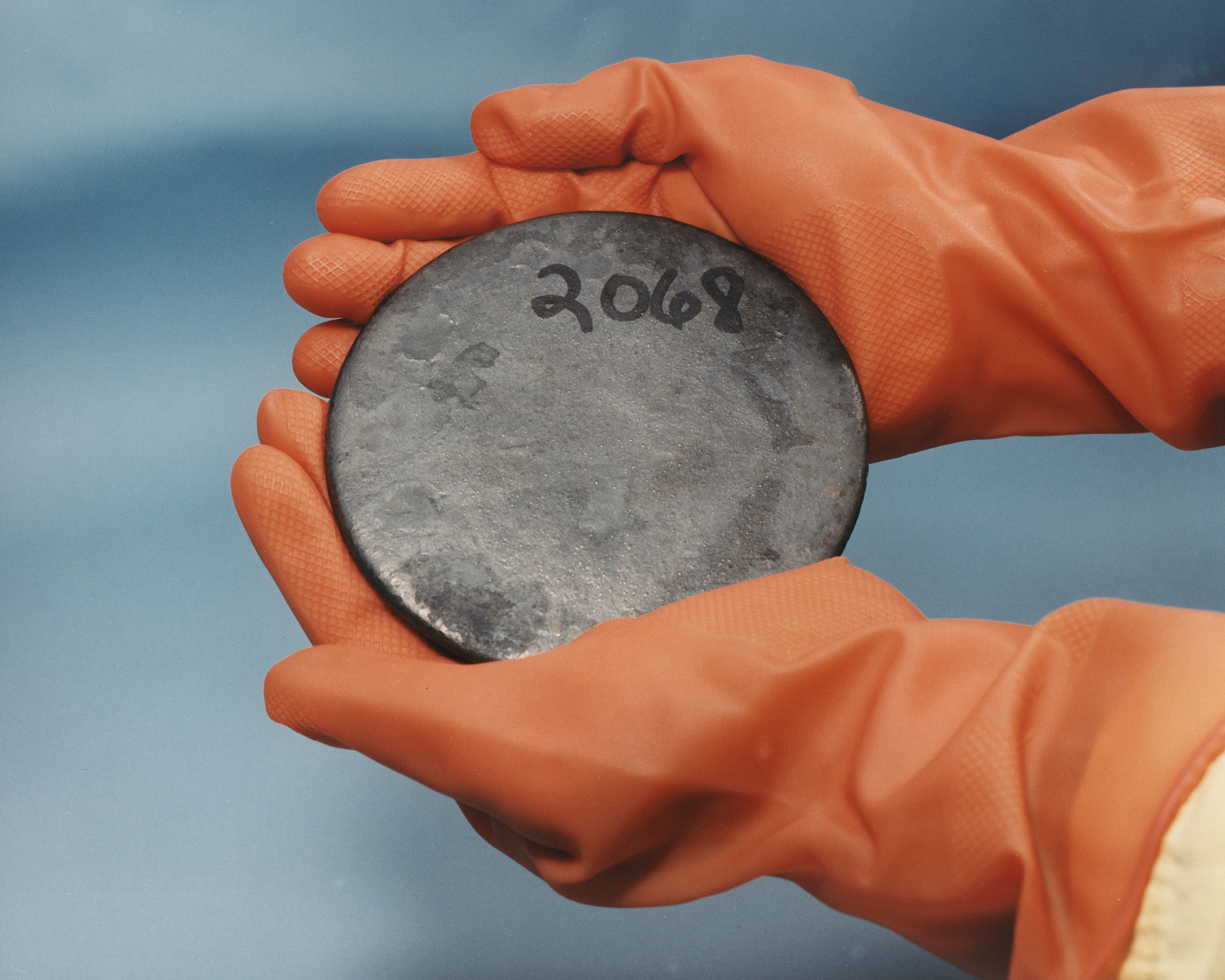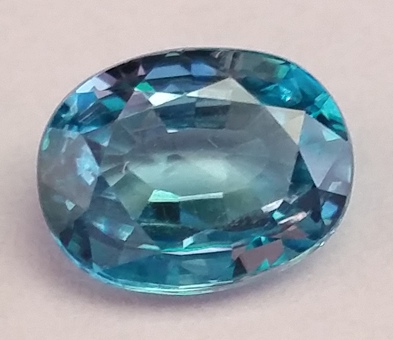|
Th-232
Thorium-232 () is the main naturally occurring isotope of thorium, with a relative abundance of 99.98%. It has a half life of 14.05 billion years, which makes it the longest-lived isotope of thorium. It decays by alpha decay to radium-228; its decay chain terminates at stable lead-208. Thorium-232 is a fertile material; it can capture a neutron to form thorium-233, which subsequently undergoes two successive beta decays to uranium-233, which is fissile. As such, it has been used in the thorium fuel cycle in nuclear reactors; various prototype thorium-fueled reactors have been designed. However, as of 2024, thorium fuel has not been widely adopted for commercial-scale nuclear power. Natural occurrence The half-life of thorium-232 (14 billion years) is more than three times the age of the Earth; thorium-232 therefore occurs in nature as a primordial nuclide. Other thorium isotopes occur in nature in much smaller quantities as intermediate products in the decay chains of uranium-238, ... [...More Info...] [...Related Items...] OR: [Wikipedia] [Google] [Baidu] |
Thorium-228
Thorium (90Th) has seven naturally occurring isotopes but none are stable. One isotope, 232Th, is ''relatively'' stable, with a half-life of 1.405×1010 years, considerably longer than the age of the Earth, and even slightly longer than the generally accepted age of the universe. This isotope makes up nearly all natural thorium, so thorium was considered to be mononuclidic. However, in 2013, IUPAC reclassified thorium as binuclidic, due to large amounts of 230Th in deep seawater. Thorium has a characteristic terrestrial isotopic composition and thus a standard atomic weight can be given. Thirty-one radioisotopes have been characterized, with the most stable being 232Th, 230Th with a half-life of 75,380 years, 229Th with a half-life of 7,917 years, and 228Th with a half-life of 1.92 years. All of the remaining radioactive isotopes have half-lives that are less than thirty days and the majority of these have half-lives that are less than ten minutes. One isotope, 229Th, has a nuc ... [...More Info...] [...Related Items...] OR: [Wikipedia] [Google] [Baidu] |
Thorium
Thorium is a chemical element; it has symbol Th and atomic number 90. Thorium is a weakly radioactive light silver metal which tarnishes olive grey when it is exposed to air, forming thorium dioxide; it is moderately soft, malleable, and has a high melting point. Thorium is an electropositive actinide whose chemistry is dominated by the +4 oxidation state; it is quite reactive and can ignite in air when finely divided. All known thorium isotopes are unstable. The most stable isotope, 232Th, has a half-life of 14.05 billion years, or about the age of the universe; it decays very slowly via alpha decay, starting a decay chain named the thorium series that ends at stable 208 Pb. On Earth, thorium and uranium are the only elements with no stable or nearly-stable isotopes that still occur naturally in large quantities as primordial elements. Thorium is estimated to be over three times as abundant as uranium in the Earth's crust, and is chiefly refined from monazite sa ... [...More Info...] [...Related Items...] OR: [Wikipedia] [Google] [Baidu] |
Fissile Material
In nuclear engineering, fissile material is material that can undergo nuclear fission when struck by a neutron of low energy. A self-sustaining thermal chain reaction can only be achieved with fissile material. The predominant neutron energy in a system may be typified by either slow neutrons (i.e., a thermal system) or fast neutrons. Fissile material can be used to fuel thermal-neutron reactors, fast-neutron reactors and nuclear explosives. Fissile vs fissionable The term ''fissile'' is distinct from ''fissionable''. A nuclide that can undergo nuclear fission (even with a low probability) after capturing a neutron of high or low energy is referred to as ''fissionable''. A fissionable nuclide that can undergo fission with a high probability after capturing a low-energy thermal neutron is referred to as ''fissile''. Fissionable materials include those (such as uranium-238) for which fission can be induced only by high-energy neutrons. As a result, fissile materi ... [...More Info...] [...Related Items...] OR: [Wikipedia] [Google] [Baidu] |
Thorite
Thorite, (Th,U)SiO4, is a rare nesosilicate of thorium that crystallizes in the tetragonal system and is isomorphous with zircon and hafnon. It is the most common mineral of thorium and is nearly always strongly radioactive. Thorite was discovered in 1828 on the island of Løvøya, Norway, by the vicar and mineralogist, Hans Morten Thrane Esmark. First specimens of Thorite were sent to his father, Jens Esmark, who was a professor of mineralogy and geology. It was named in 1829 to reflect its thorium content. Occurrence Specimens of thorite generally come from igneous pegmatites and volcanic extrusive rocks, hydrothermal veins and contact metamorphic rocks. It is also known to occur as small grains in detrital sands. Crystals are rare, but when found can produce nicely shaped short prismatic crystals with pyramidal terminations. It is commonly associated with zircon, monazite, gadolinite, fergusonite, uraninite, yttrialite and pyrochlore. Thorite is currently an import ... [...More Info...] [...Related Items...] OR: [Wikipedia] [Google] [Baidu] |
Zircon
Zircon () is a mineral belonging to the group of nesosilicates and is a source of the metal zirconium. Its chemical name is zirconium(IV) silicate, and its corresponding chemical formula is Zr SiO4. An empirical formula showing some of the range of substitution in zircon is (Zr1–y, REEy)(SiO4)1–x(OH)4x–y. Zircon precipitates from silicate melts and has relatively high concentrations of high field strength incompatible elements. For example, hafnium is almost always present in quantities ranging from 1 to 4%. The crystal structure of zircon is tetragonal crystal system. The natural color of zircon varies between colorless, yellow-golden, red, brown, blue, and green. The name derives from the Persian ''zargun'', meaning "gold-hued". This word is changed into " jargoon", a term applied to light-colored zircons. The English word "zircon" is derived from ''Zirkon'', which is the German adaptation of this word. Yellow, orange, and red zircon is also known as " hyacint ... [...More Info...] [...Related Items...] OR: [Wikipedia] [Google] [Baidu] |
Allanite
Allanite (also called orthite) is a sorosilicate group of minerals within the broader epidote group that contain a significant amount of rare-earth elements. The mineral occurs mainly in metamorphosed clay-rich sediments and felsic igneous rocks. It has the general formula A2M3Si3O12 H where the A sites can contain large cations such as Ca2+, Sr2+, and rare-earth elements, and the M sites admit Al3+, Fe3+, Mn3+, Fe2+, or Mg2+ among others. However, a large amount of additional elements, including Th, U, Be, Zr, P, Ba, Cr and others may be present in the mineral. The International Mineralogical Association lists four minerals in the allanite group, each recognized as a unique mineral: allanite-(Ce), allanite-(La), allanite-(Nd), and allanite-(Y), depending on the dominant rare earth present: cerium, lanthanum, neodymium or yttrium. Allanite contains up to 20% rare-earth elements and is a valuable source of them. The inclusion of thorium and other radioactive elements in allanit ... [...More Info...] [...Related Items...] OR: [Wikipedia] [Google] [Baidu] |
Monazite
Monazite is a primarily reddish-brown phosphate mineral that contains rare-earth elements. Due to variability in composition, monazite is considered a group of minerals. The most common species of the group is monazite-(Ce), that is, the cerium-dominant member of the group. It occurs usually in small isolated crystals. It has a hardness of 5.0 to 5.5 on the Mohs scale of mineral hardness and is relatively dense, about 4.6 to 5.7 g/cm3. There are five different most common species of monazite, depending on the relative amounts of the rare earth elements in the mineral: * monazite-(Ce), (the most common member), * monazite-(La), , * monazite-(Nd), , * monazite-(Sm), , * monazite-(Pr), . The elements in parentheses are listed in the order of their relative proportion within the mineral: lanthanum is the most common rare-earth element in monazite-(La), and so forth. Silica () is present in trace amounts, as well as small amounts of uranium and thorium. Due to the alpha decay o ... [...More Info...] [...Related Items...] OR: [Wikipedia] [Google] [Baidu] |
Pyrochlore
Pyrochlore () is a mineral group of the niobium end member of the pyrochlore supergroup. Pyrochlore is also a term for the crystal structure ''F''dm. The name is from the Greek , ''fire'', and , ''green'' because it typically turns green on ignition in classic blowpipe analysis. Mineral The general formula, (where A and B are metals), represent a family of phases isostructural to the mineral pyrochlore. Pyrochlores are an important class of materials in diverse technological applications such as luminescence, ionic conductivity, nuclear waste immobilization, high-temperature thermal barrier coatings, automobile exhaust gas control, catalysts, solid oxide fuel cell, ionic/electrical conductors etc. The mineral is associated with the metasomatic end stages of magmatic intrusions. Pyrochlore crystals are usually well-formed (euhedral), occurring usually as octahedra of a yellowish or brownish color and resinous luster. It is commonly metamict due to radiation damage from includ ... [...More Info...] [...Related Items...] OR: [Wikipedia] [Google] [Baidu] |
Decay Chain Thorium
Decay may refer to: Science and technology * Bit decay, in computing * Decay time (fall time), in electronics * Distance decay, in geography * Software decay, in computing Biology * Decomposition of organic matter * Mitochondrial decay, in genetics * Tooth decay (dental caries), in dentistry Physics * Optical decay, in quantum physics * Orbital decay, the process of prolonged reduction in the height of a satellite's orbit * Particle decay * Radioactive decay * False vacuum decay Mathematics * Exponential decay Psychology and sociology * Decay theory, in psychology and memory * Social decay (decadence), in sociology * Urban decay, in sociology Entertainment * Network decay (channel drift), in television programming * Decay (DC Comics), a comic book character * '' Half-Life: Decay'', a 2001 video game add-on * Deekay, a Danish production team * Decay (professional wrestling), a professional wrestling stable in TNA Wrestling Film * ''Decay'' (2012 film), a 2012 zombie fi ... [...More Info...] [...Related Items...] OR: [Wikipedia] [Google] [Baidu] |
Xenotime
Xenotime is a rare-earth phosphate mineral, the major component of which is yttrium orthophosphate ( Y P O4). The phosphate ions are described by a tetrahedral shape and coordinate to the center Y3+ metal ion in a way that closely resembles the structure of zircon (ZrSiO4). It forms a solid solution series with chernovite-(Y) ( Y As O4) and therefore may contain trace impurities of arsenic, as well as silicon dioxide and calcium. Other iso-structural ions that undergo exchanges with PO4 are VO4 and NbO4 ions, contributing to the list of possible co-occurring elements that may be in need of separation. The rare-earth elements dysprosium, erbium, terbium and ytterbium, as well as metal elements such as thorium and uranium (all replacing yttrium) are the expressive secondary components of xenotime. Due to uranium and thorium impurities, some xenotime specimens may be weakly to strongly radioactive. Lithiophyllite, monazite and purpurite are sometimes grouped with xenotime in the in ... [...More Info...] [...Related Items...] OR: [Wikipedia] [Google] [Baidu] |
Apatite
Apatite is a group of phosphate minerals, usually hydroxyapatite, fluorapatite and chlorapatite, with high concentrations of Hydroxide, OH−, Fluoride, F− and Chloride, Cl− ion, respectively, in the crystal. The formula of the admixture of the three most common Endmember (mineralogy), endmembers is written as Calcium, Ca10(Phosphate, PO4)6(OH,F,Cl)2, and the crystal unit cell formulae of the individual minerals are written as Ca10(PO4)6(OH)2, Ca10(PO4)6F2 and Ca10(PO4)6Cl2. The mineral was named apatite by the German geologist Abraham Gottlob Werner in 1786, although the specific mineral he had described was reclassified as fluorapatite in 1860 by the German mineralogist Karl Friedrich August Rammelsberg. Apatite is often mistaken for other minerals. This tendency is reflected in the mineral's name, which is derived from the Greek word ἀπατάω (apatáō), which means ''to deceive''. Geology Apatite is very common as an accessory mineral in igneous and metamorphic roc ... [...More Info...] [...Related Items...] OR: [Wikipedia] [Google] [Baidu] |





